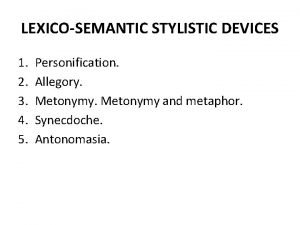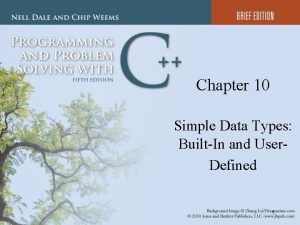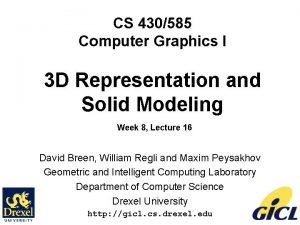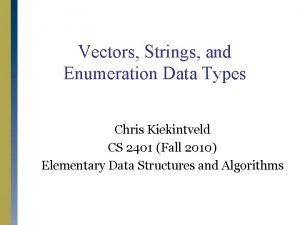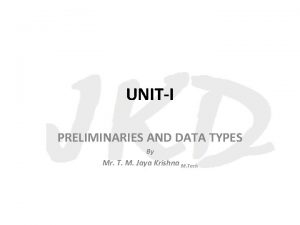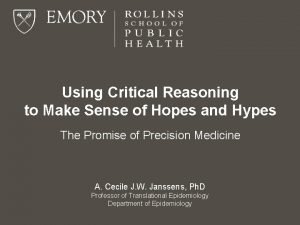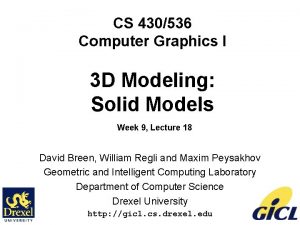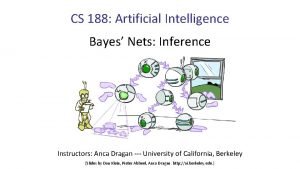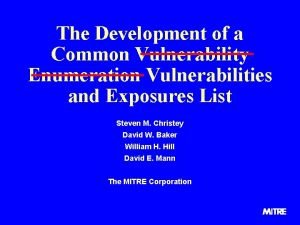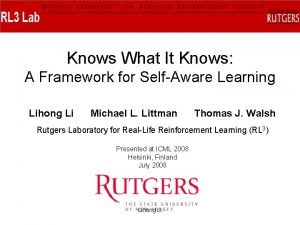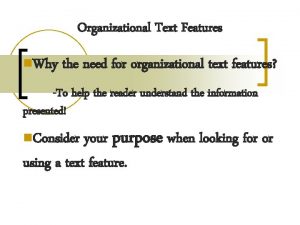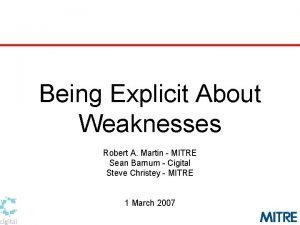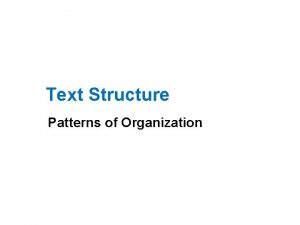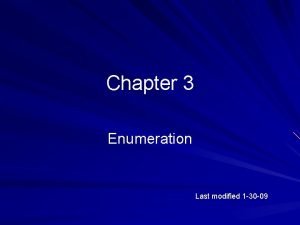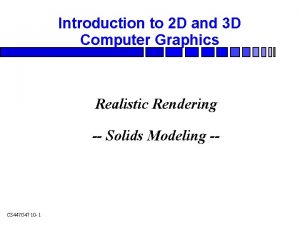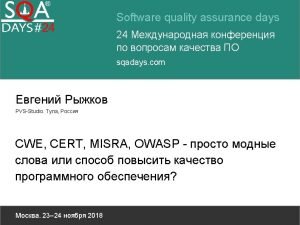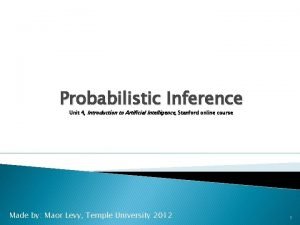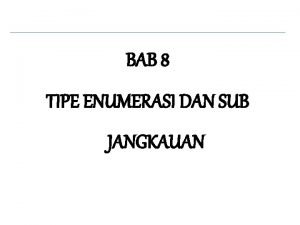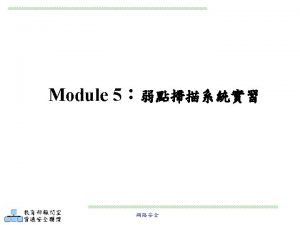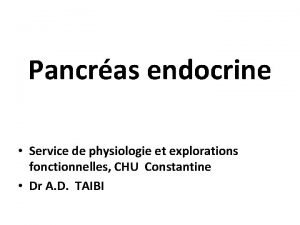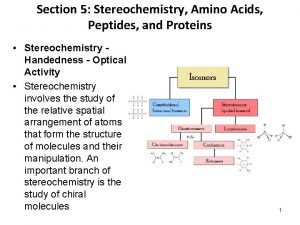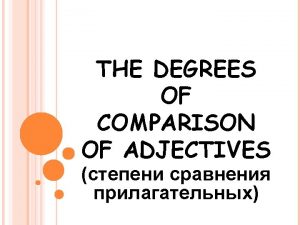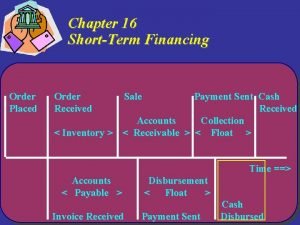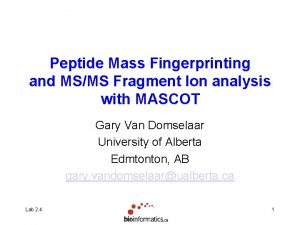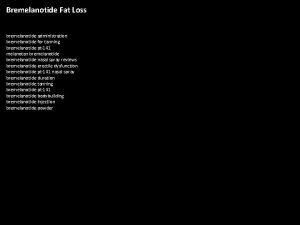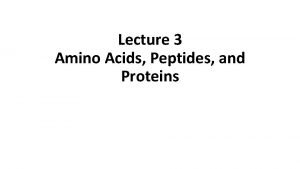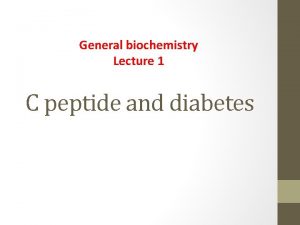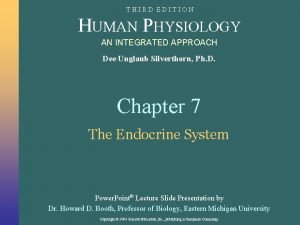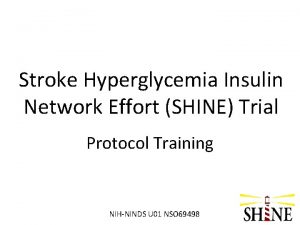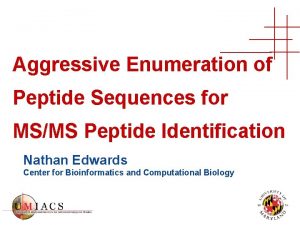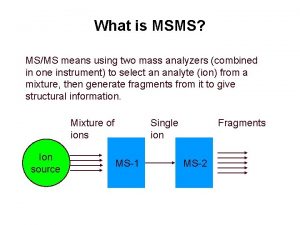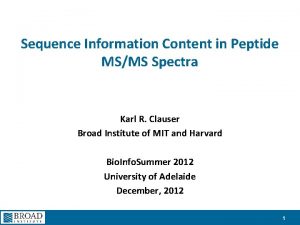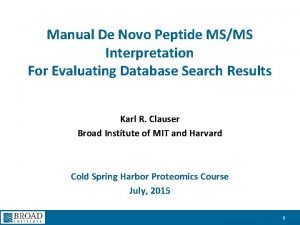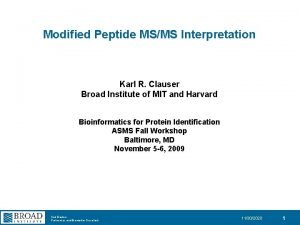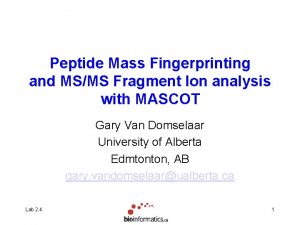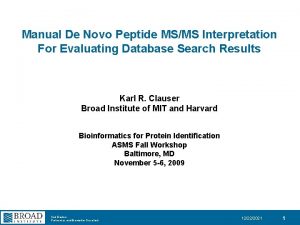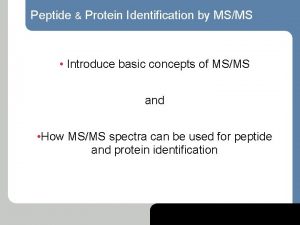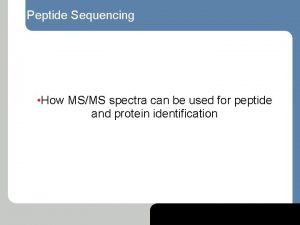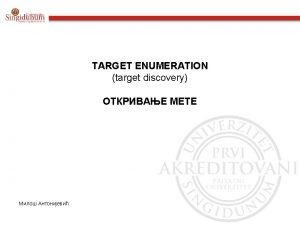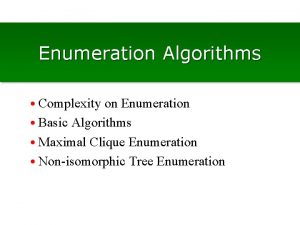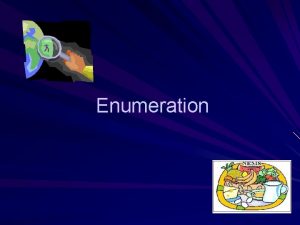Aggressive Enumeration of Peptide Sequences for MSMS Peptide






















![EST Peptides • Frame 1 translation CTTKFCDYGKA PGAEEYAQQDV LKKSYSKAFTL TISALFVTPKT TGA[QPRL]VELSEQQ LQL[S*LW]PSDVDKL SPTD[IKMNSRT] 23 EST Peptides • Frame 1 translation CTTKFCDYGKA PGAEEYAQQDV LKKSYSKAFTL TISALFVTPKT TGA[QPRL]VELSEQQ LQL[S*LW]PSDVDKL SPTD[IKMNSRT] 23](https://slidetodoc.com/presentation_image_h2/c354de8b84449b7a0655ef8da70d17d1/image-23.jpg)






















- Slides: 45

Aggressive Enumeration of Peptide Sequences for MS/MS Peptide Identification Nathan Edwards Center for Bioinformatics and Computational Biology

Mass Spectrometer Sample + _ Ionizer • MALDI • Electro-Spray Ionization (ESI) Mass Analyzer • Time-Of-Flight (TOF) • Quadrapole • Ion-Trap 2 Detector • Electron Multiplier (EM)

Mass Spectrometer (MALDI-TOF) UV (337 nm) Source Field-free drift zone Pulse voltage Analyte/ matrix Ed = 0 Length = s Backing plate (grounded) Microchannel plate detector Length = D Extraction grid (source voltage -Vs) Detector grid -Vs 3

Mass is fundamental 4

Sample Preparation for MS/MS Enzymatic Digest and Fractionation 5

Single Stage MS MS 6

Tandem Mass Spectrometry (MS/MS) Precursor selection 7

Tandem Mass Spectrometry (MS/MS) Precursor selection + collision induced dissociation (CID) MS/MS 8

Peptide Fragmentation yn-i-1 -HN-CH-CO-NHCH-R’ i+1 Ri R” i+1 bi 9

Peptide Fragmentation S G F L E E D E L K % Intensity 100 0 250 500 10 750 1000 m/z

Peptide Fragmentation 88 S 1166 145 G 1080 292 F 1022 405 L 875 534 E 762 663 E 633 778 D 504 1020 L 260 1166 K 147 b ions y 6 100 % Intensity y 7 y 5 b 3 y 2 0 907 E 389 250 y 3 b 4 y 4 b 5 500 b 6 11 b 7 750 b 8 y b 9 8 y 9 1000 m/z

MS/MS Search Engines • Fail when peptides are missing from sequence database • Protein sequence databases serve many masters • Full length protein sequences not needed for MS/MS • Explicit variant enumeration is needed for MS/MS • Much peptide sequence information is lost, inaccessible, or not integrated • Protein isoforms, sequence variants, SNPs, alternate splice forms, ESTs • Some peptides are more interesting than others • Protein identification is only part of the story 12

Human Sequences PIR • Number of Human Genes is believed to Swiss. Prot be between 20, 000 and 25, 000 Ref. Seq ~ 10, 500 ~ 12, 000 ~ 28, 000 IPI-HUMAN ~ 48, 000 Tr. EMBL ~ 52, 000 MSDB ~ 105, 000 13

DNA to Protein Sequence Derived from http: //online. itp. ucsb. edu/online/infobio 01/burge 14

UCSC Genome Brower 15

Genomic Peptide Sequences • Many putative peptide sequences never become “protein” sequences • Genomic DNA, • Refseq m. RNA, ESTs • SNP/Polymorphism databases • Variant records in Swiss. Prot • Genomic annotation seeks “full length” genes and proteins 16

Genomic Peptide Sequences • Genomic DNA • Exons & introns, 6 frames, large (3 Gb → 6 Gb) • Refseq m. RNA • No introns, 3 frames, small (36 Mb → 36 Mb) • Most protein sequences already represented in sequence databases • ESTs • No introns, 6 frames, large (3 Gb → 6 Gb) • Used by gene & alternative splicing pipelines • Highly redundant, nucleotide error rate ~ 1% 17

“Novel” Peptide 18

Novel peptide 19

EST Peptides • 6 frame translation • Ambiguous base enumeration (up to a point) • Break at non-amino-acids • stop codons + X • Discard AA sequence < 50 AA long • Result: ~ 3 Gb • Not as simple as it sounds! 20

EST Peptides • Lots of ambiguous bases • >gi|272208|gb|M 61958. 1| TGCACAACCAAGTTTTGTGACTACGGGAAGGCT CCCGGGGCAGAGGAGTACGCTCAACAAGATGTG TTAAAGAAATCTTACTCCAAGGCCTTCACGCTG ACCATCTCTGCCCTCTTTGTGACACCCAAGACG ACTGGGGCCCNGGTGGAGTTAAGCGAGCAGCAA CTNCAGTTGTNGCCGAGTGATGTGGACAAGCTG TCACCCACTGACA 21

Codon Table 22
![EST Peptides Frame 1 translation CTTKFCDYGKA PGAEEYAQQDV LKKSYSKAFTL TISALFVTPKT TGAQPRLVELSEQQ LQLSLWPSDVDKL SPTDIKMNSRT 23 EST Peptides • Frame 1 translation CTTKFCDYGKA PGAEEYAQQDV LKKSYSKAFTL TISALFVTPKT TGA[QPRL]VELSEQQ LQL[S*LW]PSDVDKL SPTD[IKMNSRT] 23](https://slidetodoc.com/presentation_image_h2/c354de8b84449b7a0655ef8da70d17d1/image-23.jpg)
EST Peptides • Frame 1 translation CTTKFCDYGKA PGAEEYAQQDV LKKSYSKAFTL TISALFVTPKT TGA[QPRL]VELSEQQ LQL[S*LW]PSDVDKL SPTD[IKMNSRT] 23

Correcting EST Sequence • Align ESTs to genome • Use aligned genomic sequence • Must get splice sites right! • 6 frame translation • Break at non-amino-acids • stop codons + X • Discard AA sequence < 50 AA long • Result: ~ 1 Gb 24

Genomic Coding Sequence • Use Genscan to predict exons • Use very low probability threshold • Alternative exons option • No need for translation (35 Mb) 25

Exon “Pair” Enumeration 30 AA • 3 2 1 4 5 4* Gene model Exon 4 w/ SNP Exon Pairs & Paths 1 2 3 1 2 4* 1 2 5 1 3 1 4* 1 5 3 4* 4 5 4* 5 3 -Frame Translation Peptide Sequence C 3 Compression 26

Peptide Candidates • Parent ion • Typically < 3000 Da • Tryptic Peptides • Cut at K or R • Search engines • Don’t handle > 4+ well • Long peptides don’t fragment well • # of distinct 30 -mers upper bounds total peptide content 27

Sequence Database Compression Construct sequence database that is • Complete • All 30 -mers are present • Correct • No other 30 -mers are present • Compact • No 30 -mer is present more than once 28

SBH-graph ACDEFGI, ACDEFACG, DEFGEFGI 29

Compressed SBH-graph ACDEFGI, ACDEFACG, DEFGEFGI 30

Sequence Databases & CSBH-graphs • Sequences correspond to paths ACDEFGI, ACDEFACG, DEFGEFGI 31

Sequence Databases & CSBH-graphs • All k-mers represented by an edge have the same count 1 2 2 1 2 32

Sequence Databases & CSBH-graphs • Complete • All edges are on some path • Correct • Output path sequence only • Compact • No edge is used more than once • C 3 Path Set uses all edges exactly once. 33

Sequence Databases & CSBH-graphs • Use each edge exactly once ACDEFGEFGI, DEFACG 34

Sequence Databases & CSBH-graphs • All k-mers that occur at least twice 1 2 2 1 2 ACDEFGI 35

36 UP-VS UP SP-VS SP IPI-H Relative Search Time

More Sensitive Peptide ID • Significances, p-values, Expect values • Normalize for number of trials • Blast: • Size of sequence database • Mascot etc. : • Number of peptides scored against each spectrum • Redundant peptide sequences increase the number of trials, artificially. • Trials are not independent! • Less redundancy results in a better significance estimate 37

More Sensitive Peptide ID 38

Human Peptide Sequences • EST enumeration • 30 -mers must occur at least twice • EST corrections • Genscan exons • Uncompressed size: ~ 4. 5 Gb • Compressed size: ~ 263 Mb 39

Infrastructure • X!Tandem open source search engine • Configured to search aggressive peptide enumeration (human) • Web interface for browsing results • Integrated with condor • Results stored in My. SQL database • Over 3 million publicly available MS/MS spectra from human samples 40

“Novel” Peptide 41

“Novel” Peptide 42

“Novel” Peptide 43

Ongoing work • Integrate SNPs and exon pairs • Get (lots) more spectra! • Solve the reverse mapping problem • Where did this peptide come from? • What protein does this peptide represent? 44

Thanks • Informatics Research @ ABI & Celera • Ross Lippert, Clark Mobarry, Bjarni Halldorsson • UMIACS @ University of Maryland, CP • V. S. Subrahmanian, Fritz Mc. Call, Doan Pham • Fenselau Lab @ UM, CP • CS @ University of Maryland, CP • Chau-Wen Tseng, Xue Wu 45
 Lc msms
Lc msms Msms icys
Msms icys Lc-msms
Lc-msms Repetition rhetorical devices
Repetition rhetorical devices Metonymy in stylistics
Metonymy in stylistics Enumeration text type
Enumeration text type Spatial occupancy enumeration in cad
Spatial occupancy enumeration in cad Enumeration text type
Enumeration text type Pleonasml
Pleonasml Concept/definition text structure
Concept/definition text structure Enumeration text type
Enumeration text type Post enumeration survey
Post enumeration survey Footprinting vs enumeration
Footprinting vs enumeration Paragraph development
Paragraph development Ano ang argumento
Ano ang argumento Spatial occupancy enumeration
Spatial occupancy enumeration Inference by enumeration in artificial intelligence
Inference by enumeration in artificial intelligence Cve common vulnerability enumeration
Cve common vulnerability enumeration Enumeration text type paragraph example
Enumeration text type paragraph example Knows what it knows: a framework for self-aware learning
Knows what it knows: a framework for self-aware learning Example of enumeration
Example of enumeration Mitre common weakness enumeration
Mitre common weakness enumeration Enumeration transition words
Enumeration transition words Adieu veaux vaches cochons couvées figure de style
Adieu veaux vaches cochons couvées figure de style Signal words example
Signal words example Wicoweb
Wicoweb Uml game design
Uml game design Intitle nessus scan report
Intitle nessus scan report Spatial occupancy enumeration
Spatial occupancy enumeration What is enumeration text type
What is enumeration text type Cve vs cwe
Cve vs cwe Inference by enumeration in artificial intelligence
Inference by enumeration in artificial intelligence System enumeration
System enumeration Common vulnerability enumeration
Common vulnerability enumeration Peptide c prise de sang
Peptide c prise de sang What is proteins
What is proteins Comparative and superlative aggressive
Comparative and superlative aggressive Aggressive financing strategy
Aggressive financing strategy Mascot peptide mass fingerprint
Mascot peptide mass fingerprint Manulife mpf aggressive fund
Manulife mpf aggressive fund Bremelanotide spray
Bremelanotide spray Questions about aggressive behavior
Questions about aggressive behavior Simple proteins
Simple proteins Elevated c peptide
Elevated c peptide Peptide hormone receptors
Peptide hormone receptors Human actrapid sliding scale
Human actrapid sliding scale




